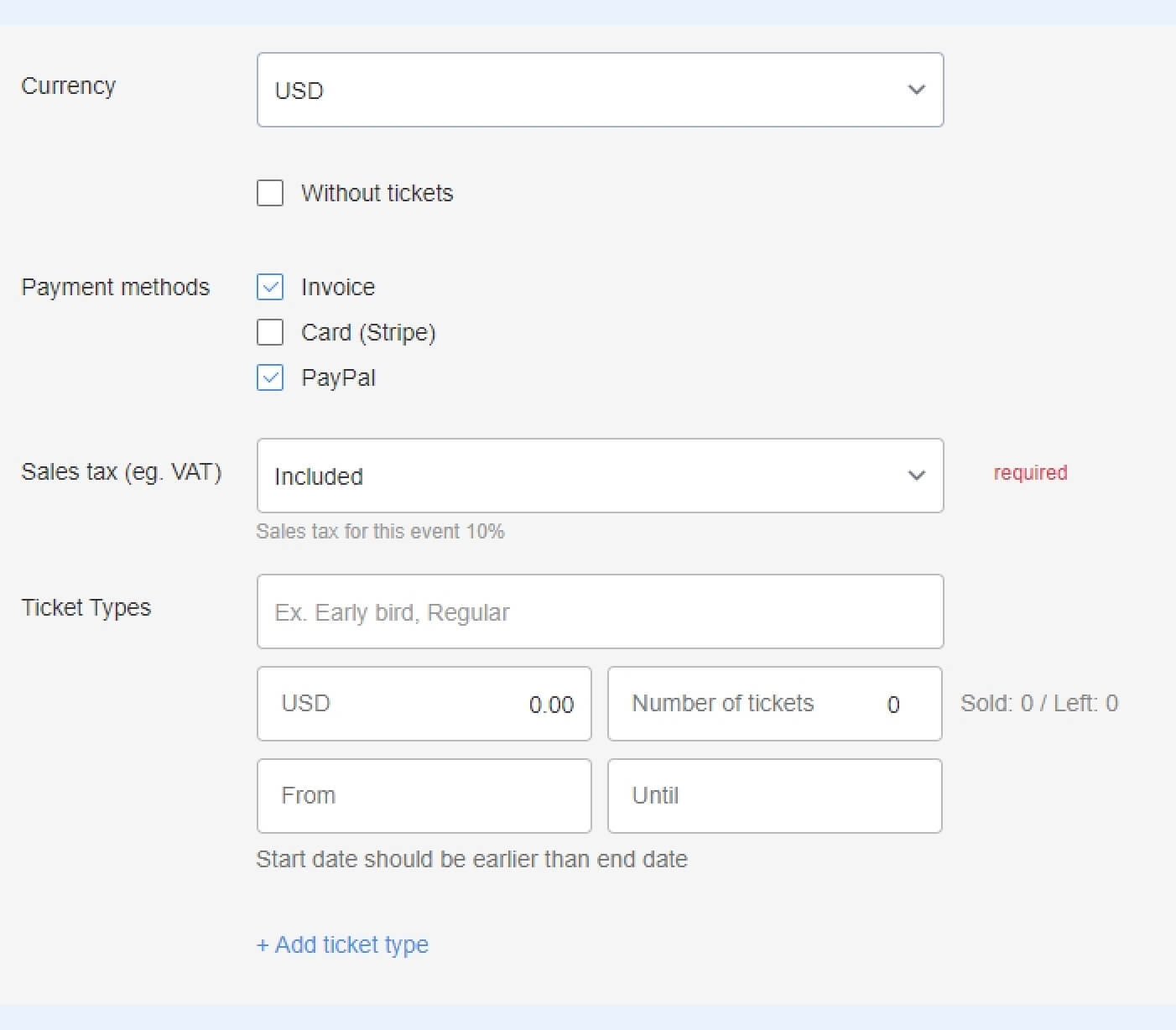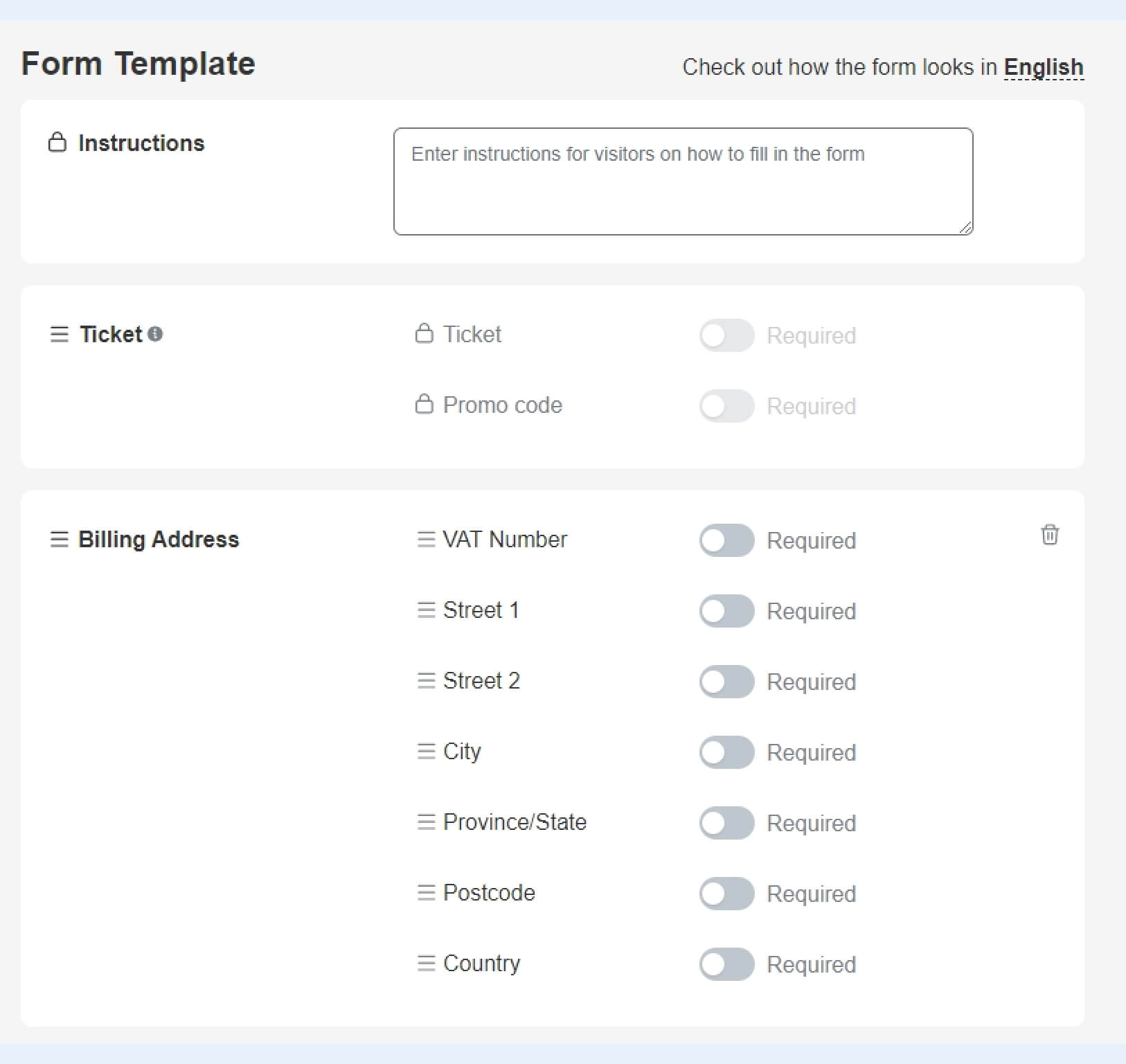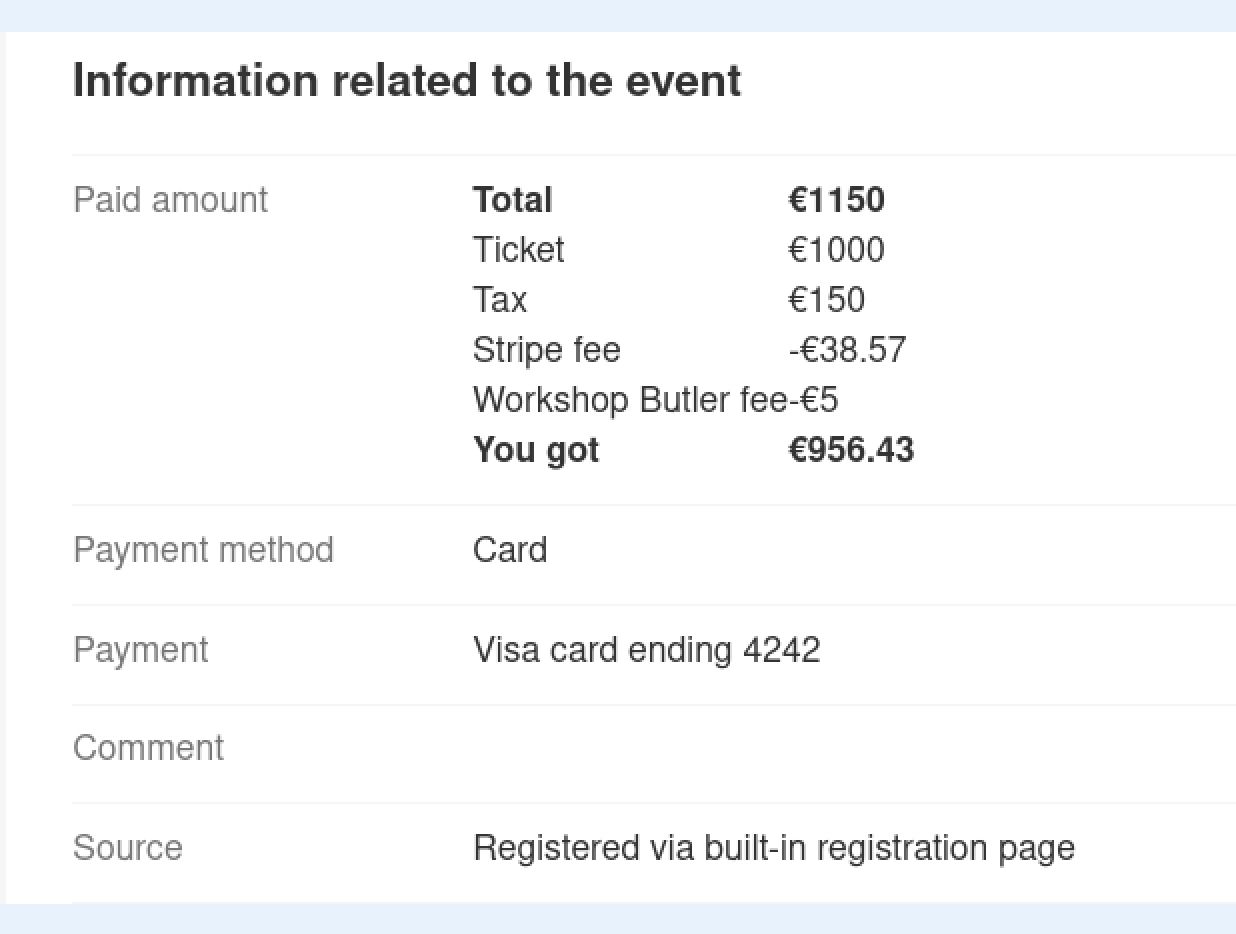There is a smarter approach to selling seats to your workshops and other events than slapping the same price tag on each ticket.
A successful ticketing strategy covers the following aspects:
- Event ticket types (or tiers)
- Discounts and promocodes
- Sales tax
- Payment methods
- Cancellation and refund options.
It walks hand in hand with pricing and marketing, providing a solid base for ticket sales.
Additionally, we recommend thinking out how you’re going to store the payment information. By analyzing it, you can notice important tendencies, that will become helpful in revenue management.
Event ticket types
Why do you need to divide your tickets into types in the first place?
The main purpose is to increase the range of people who can afford your services or are interested in them. By using tiered pricing you cater to people with different needs and different budgets. Someone would be happy to attend but cannot afford a regular ticket — suggest they come with a friend and charge them less. Another person, on the contrary, would be interested in discussing their personal needs and be willing to pay more for this — offer a VIP ticket to such clients.
The wider the range of tickets you offer, the more circumstances you take into account. This means more people decide that your event is worth attending.
Another benefit is the psychological effects of the choice you give. By comparing different prices for different tiers people might perceive one of them as a good deal. And by seeing that some types are sold out already, they might sense the urge to secure a seat without delay.
These factors play into your hands rising attendance numbers and convincing people they made the right choice.
Let’s see what ticket types are the most suitable for training workshops.
Regular (General Admission) tickets — just your standard type at the price which you think would be right for your workshop. It doesn’t offer any extra services or discounts. Instead, it serves as the yardstick for a potential customer to understand how profitable other types are.
Early Bird tickets go on sale before all the other types for those who are ready to commit early. Having sold several Early Birds, you can be sure that the event will take place. And this, in turn, allows you to be more confident in your schedule and your income. Early Bird includes all the usual benefits but costs less than a Regular ticket — a reward for early commitment.
Group tickets allow the attendance of 2 or more people. In exchange for securing more than one seat at once, both students pay a lower price. By offering this ticket, you make students bring more people, thus increasing attendance. It’s possible to offer more than one ticket tier for groups. For example, for a group of 2 and for a group of 3 — the more people the ticket is intended for, the lower the price for each ticket buyer.
VIP tickets are different from the previous types because they cost more, not less, and offer premium services. It can be your personal consultation which takes place after an event and is related somehow to an event topic. Another VIP option can be membership in the community if you have one. VIP ticket shows what else you have to offer apart from conducting the training session itself.
There are other ticket types for different kinds of events, which can also be applied to training workshops. For example, a one-day ticket allows attendance for one day of the event that lasts several days and an all-day pass covers the whole duration. Another approach is to charge different prices for online and in-person attendance. Charge less for a virtual event, where you don't have to rent a venue and offer more hands-on experience on the offline session for a higher price.
How to display ticket types
The trick is to show the distinctive difference between various types while emphasizing the benefits of each one. You need to explain what they include giving people a chance to compare them. It’s also important to maintain a sense of urgency in the potential ticket buyers.
What elements can help you with all these tasks?
- A type name. It’s better to stick to traditional names like “Early Bird” because many people are already familiar with them and you won’t have to explain what they mean.
- A short description of what each type includes.
- A price. Deciding on the ticket pricing strategy plays a central role in the event ticket sales.
- A countdown timer or end date. They will create the fear of missing out making potential attendees hurry up and buy tickets.
- Start of sales date if some of the types are not available yet. People need to know when they can buy the type they like.
- Sold Out label. It helps increase the sense of urgency creating an impression that other tickets might get sold out soon too.
- A number of tickets left. This parameter works especially well when there are almost no seats left.
We recommend always displaying the price for the Regular type because it highlights the advantages of others. So, even before it goes on sale and only the Early Bird is available, the Regular ticket price should already be there for people to see the benefits of early commitment.
Alternatively, you can show the percentage of the benefit for each type — e.g. 30% Off.
It’s also best to show all tiers next to each other on one page rather than making a switch between them. This way, it will be easier to compare them.
Apart from choosing the elements you will include in the Tickets block, you also need to decide where this block will be positioned on the page. Think about how you are going to describe your event and where the tickets would fit best.
One way is to place it at the top of an event page as it's one of the crucial details that everyone should see from the start. However, if a page visitor considers the price too high, they might leave without even looking at the description. Another option is to put tickets at the bottom of the page after you laid out all information about an event and showed why it’s priced like this.
Discounts and promo codes
Running discounts or including a promo code field next to your tickets is a good way to drive attendance. Different discounts can serve different purposes.
Discounts for non-commercial organizations and discussable prices
You can offer a lower price for non-commercial organizations to give them a chance to participate. You can also place a disclaimer that, if a person wants to take part in your class but is tight on the budget right now, they can contact you to discuss possible options. Depending on the circumstances, you can offer a discount or suggest taking part in a similar event.
Such offers can contribute to your reputation as a flexible entrepreneur who is willing to help those in need.
Discounts for previous attendees, for bringing a friend, or for community members
Offer discounts to those who have already taken part in your events before or for those who can bring more people to your event. This way, you will encourage people to attend your next classes.
Discounts on special occasions like Black Friday
Holidays or other special occasions are your chance to offer discounts to everyone, without any special conditions they must meet.
Discounts for cancellation
If something went wrong and one of your previous sessions got cancelled, offer a discount to those who have registered to it already. This gesture will soften an unpleasant experience, encouraging a potential participant to try another time. You can include a promo-code to the event cancellation email along with apologies.
Last-minute ticket sale
There is a good chance to secure more attendees when your event is about to start — run a sale a few days before. It might be better to sell a ticket with a discount, that to sell nothing at all. Although that's not the method you should rely on heavily. Otherwise, people will get used to it and will be waiting for it to buy tickets.
Sales tax
Taxes stand apart from the cost of the ticket. They’re the factor that can change the final price depending on the country or other circumstances.
Therefore, you need to decide how to handle them.
How to display taxes
There are two ways you can display taxes, both having their benefits.
Including tax in the final price. You can show the final price (ticket price + tax) right away, saving your potential attendees from making any calculations. Many people don’t care what the final price consists of — they’re more interested in how much they will have to pay.
Excluding tax from the final price. You can show the tax separately from the price to let people know what the real price is and how much you have to add to comply with the law.

Important points to consider
Handling taxes right means more than simply finding out the tax rate of your country. It’s a complex matter defined by many factors. Here are the main aspects you should check when calculating the sales tax:
- Tax registration threshold — for some cases, you don’t have to pay a tax if your sales are below a certain amount. This threshold can be different depending on the country or the nature of your business.
- Country your customers live in — sales tax is named differently in different parts of the world and has different rates.
- Who is your target audience — another business or a private individual? Sometimes, paying a tax for a b2b transaction becomes your prospective attendee’s responsibility and that’s what needs to be handled correctly too.
- Format: a virtual event or offline class. In some countries, certain forms of online learning are not taxed. If you’re focused solely on online training the tax burden might be lighter than expected.
- How often to submit the tax return — you need to know it to plan your budget. This parameter affects your ticket prices, your schedule, and your revenue.
Find out anything possible beforehand or consult specialists to plan your events right.
Payment methods
The country where you conduct events and the type of customers you deal with can affect your choice of payment methods.
Of course, it doesn’t mean that you need to add a new payment method every time you work in a new place. But you can choose the most popular ones in the countries you often work with or the most convenient ones for your target audience.
Bank card
Everyone has a bank card and gets used to paying with it. This way is the most common in b2c transactions because it’s fast and doesn’t require a lot of actions. However, in the initial stage, you will have to spend some time to find a suitable payment getaway (e.g. Stripe) and they will charge their own small fee for each ticket.
PayPal
If you don’t want to choose between different payment solutions trying to find the best one and would like to get a ready-to-go way, then PayPal is another good and speedy choice for b2c payments. The problem here is that not everyone has a PayPal account.
Invoicing
What if your customers are mostly organizations and not individuals? Then you might consider invoices which stays one of the most preferred methods of payment in the business world. There are a lot of apps (including free ones) for creating and managing invoices. The main downside of this method is that it can be time-consuming to send invoices and wait till everyone pays them.
Cancellation and refund
Cancellation is not something you’d want to happen, yet it’s still one of the possible outcomes.
For a ticket buyer, it’s important to know that there is a way to turn back if they can’t make it to your event, especially if it’s a long-term commitment.
And you as an event organizer need to think over your steps beforehand. This way, you will be able to react quickly and have a chance to leave a good impression even in such an unpleasant situation.
Deadline for canceling participation. Clearly specify it to avoid any conflicts.
Refund options. Will it be the whole sum or only a part of it? Naturally, for a customer, it would be preferable to get a full refund. But for all the expenses on organization and marketing, you might want to keep a part of the sum regardless of cancellation.
Sometimes, there can be several deadlines with different refund options. Canceling before the first one means a full refund, and canceling before the second one — 50% of the sum.
Replacement options. The fact that a person can’t take part in this particular event doesn’t mean that they won’t be able to attend other ones. Try offering them to participate on a different date to keep both a student and the money. Another way to keep the money despite cancellation is to allow another person to attend instead of the one who registered initially. For example, a person can bring their colleague instead of themselves.
Contact means. The most important thing is to specify how to contact you about the cancellation. Will it be email or social networks, should there be a particular subject line? Explain what a person should do to make sure you won’t miss such a message.
Storing payment info
It’s better to store the payment information about the tickets you sold so that you can quickly access it anytime.
Why would you need to store it?
First, analyzing preferable payment methods, ticket types, discounts, and other info will help you improve your strategy and cater to your customers’ needs better. And second, in case there is a dispute or some questions, you need to be able to retrieve the data quickly to deal with it as soon as possible.
What information to store
Think about what payment info you need before starting event registration. Thus you will be able to request all the necessary details and record them.
The following info might be useful:
- Billing address
- Date of payment
- Payment method
- Total amount paid
- Tax rate applied
- Commission of payment providers (e.g. Stripe fee) and any other services you use to accept payments
- The amount of tax charged
- TAX ID number, if any.
Breaking down each payment into the price itself, taxes, various fees and commissions will save you time later.
How to store
In order to quickly find the necessary information, you need to structure it and follow this structure with all the payment info you have.
One way is to organize information by events. If you keep it in the calendar order, you can easily find it by date. If you conduct several types of workshops, you can additionally sort payment details by this parameter as well.
Another way is to organize it by event attendees. You need to keep track of a participation history which will contain data about all events this person took part. By organizing it in alphabetical order you can quickly find the person you need by name.
Automating the whole process
As you see, there are a lot of factors involved in setting up the smooth process of selling tickets and keeping information about all payments. And even after all the steps are figured out, you will have to spend a significant portion of time before and after each event performing them.
We suggest considering automated solutions, which will take upon themselves the most time-consuming tasks.
You can use a special platform like Ticket Tailor that focus solely on online ticket sales and have the necessary features ready.
But there is an even more automated way that will handle for you the whole process of event management with tickets, taxes, and payment info as its parts. Workshop Butler provides such a solution.
Here, you can add ticket types and set the number of tickets, prices, and start and end selling dates. You can choose among 3 payment methods (bank cards, PayPal, invoices) and choose the way to display taxes: included or excluded from the price.

The information you add will be displayed on your website with the help of integrations allowing your potential attendees to compare tickets and choose the one they want.
When you decide which payment info you need, you can add corresponding questions to a fully customizable registration form.

The information about each payment is stored in the system without limitations. You can access it either via the list of participants on the event page or via the list of all your attendees. We break down the price into components showing you how much you received and how much went to various fees and taxes.

It might take several attempts to nail the ticketing strategy that works for you. The key here is to carefully analyze each step in the payment process for every event to see what works well and what needs revision. Don’t be afraid to test new tactics, ask your students’ opinion on what they liked and what they missed, try different services specializing in event management — and, eventually, you will be able to build the perfect plan for filling the seats at your classes and sharing your knowledge with as many people as possible.

